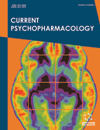- Home
- A-Z Publications
- Current Psychopharmacology
- Previous Issues
- Volume 8, Issue 1, 2019
Current Psychopharmacology - Volume 8, Issue 1, 2019
Volume 8, Issue 1, 2019
-
-
The Assessment of ‘Sleepiness’ in Human Drug Trials: A New Perspective
More LessBy Murray JohnsThe investigation of the efficacy and safety of drugs requires assessments of their effects on alertness/sleepiness. Unfortunately, there is confusion about the nature of ‘sleepiness’, the factors which influence it, and how it can be measured under different circumstances. This review aims to clarify these matters and to offer some suggestions about how current difficulties might be overcome. Different meanings of the word ‘s Read More
-
-
-
Protein Chimera-based Ca2+ Rewiring as a Treatment Modality for Neurodegeneration
More LessAuthors: Netra U. Rajesh and Anam QudratCalcium is a versatile signaling molecule; a key regulator of an array of diverse cellular processes ranging from transcription to motility to apoptosis. It plays a critical role in neuronal signal transmission and energy metabolism through specialized mechanisms. Dysregulation of the Ca2+ signaling pathways has been linked to major psychiatric diseases. Here, we focus on molecular psychiatry, exploring the role of cal Read More
-
-
-
Psychopharmacology for Patients with Parkinson’s Disease and Deep Brain Stimulation: Lessons Learned in an Academic Center
More LessAuthors: Andreea L. Seritan, Peter Ureste, Tammy Duong and Jill L. OstremBackground: Deep brain stimulation (DBS) is a modern neuromodulation method used in the treatment of advanced movement disorders such as Parkinson’s disease (PD) and dystonia. Patients with PD may have multiple psychiatric comorbidities, notably anxiety, depression, mania or hypomania, and psychosis. DBS surgery may indirectly alleviate psychiatric symptoms by allowing reduction of dopaminergic medication Read More
-
-
-
Comparative Evaluation of A Partial Dopamine Agonist with A Preferential D2 and D3 Receptor Antagonist on Ethanol Induced Conditioned Place Preference in Mice
More LessAuthors: Muhammad A. Yazdani, Muhammad Jamir Anwar, Bushra Parveen and Divya VohoraBackground: The role of dopamine receptor sub-families in the rewarding and reinforcing effects of drugs of abuse has been established in numerous studies. Objectives: In view of the extensive role of mesolimbic dopaminergic transmission in rewarding and reinforcing effect of abused drugs including ethanol, the present study evaluated three mechanistically different drugs viz a partial dopaminergic agonist (PDA, aripip Read More
-
-
-
Substance Use Disorder Related to Kratom (Mitragyna speciosa) Use in Malaysia
More LessBackground: Kratom is a traditional medicinal herb with mild addictive properties. Nevertheless, current available data on substance use disorder related to kratom use is scarce. This study aims to clinically evaluate and identify factors that are associated with kratom use disorder among regular kratom tea/juice users in traditional settings in Malaysia. Method: 150 regular kratom users were recruited through convenient s Read More
-
-
-
Systemic Injections of Primidone Cause Wake-Inducing Effects in Rats
More LessBackground: Essential Tremor (ET) is a disease present in neurodegenerative disorders, such as Parkinson´s disease. Besides the motor dysfunction, ET also causes sleep problems, including excessive daytime sleepiness. To manage ET, several compounds are prescripted, such as primidone. However, no evidence is available regarding the effects of primidone on sleep. Objective: We analyzed the effects of systemi Read More
-
-
-
Neurobehavioral Effects of β-Escin
More LessAuthors: Huda J. Waheed, Saad B. Nashtar, Ali I. Al-Gareeb and Hayder M. Al-KuraishyBackground: Aescin or β-escin is the main and active constituent of horse chestnut seed (Aesculus hippocastanum) used for the treatment of inflammatory edema, venous insufficiency and ischemic ulcerations. Aescin has many actions due to induction of endothelial nitric oxide and prostaglandin F2-α production moreover; aescin antagonizes the effect of histamine and 5HT at receptor levels. Objective: The aim of th Read More
-
Most Read This Month
Article
content/journals/cpsp
Journal
10
5
false
en


